Indulge in a heavenly fusion of flavors with these ube cinnamon rolls, where the vibrant and sweet essence of ube meets the warmth of cinnamon. These ube rolls are irresistibly soft, fluffy, and aromatic. This perfectly curated recipe is sure to yield you a delightful treat.

Ube cinnamon rolls are a unique twist to the classic cinnamon rolls. Ube, also known as purple yam, is a popular ingredient in Filipino desserts and is known for its vibrant purple color. Combining the sweet and nutty flavor of ube with the warmth of cinnamon creates a delicious and comforting treat.
This is going to be the third ube recipe on the blog, after ube bread and ube milk tea.
Making ube cinnamon rolls may seem daunting, but with a few simple steps, you can have freshly baked ube cinnamon rolls that are perfect for breakfast, brunch, or dessert. They are a great way to add some variety to your baking repertoire, and they are sure to impress your friends and family.
Jump to:
🍶 Ingredient Notes: Ube Cinnamon Rolls
Ingredients for making dough
- Bread Flour: This is the main flour for the ube rolls, providing structure and texture. If you don't have bread flour, you can use all-purpose flour as a substitute, but the rolls may be slightly less chewy.
- Whole Milk: Adds richness and moisture to the dough. You can substitute with any non-dairy milk for making vegan ube cinnamon rolls, but keep in mind that it might alter the flavor slightly.
- Sugar: Sweetens the dough and enhances browning. You can replace it with honey or maple syrup for a different flavor profile.
- Active Dry Yeast: Essential for leavening the dough. Instant yeast can be used as a substitute but follow the conversion instructions on the package as it may require less quantity.
- Unsalted Butter: Provides richness and flavor to the dough. Margarine or a plant-based butter substitute can be used for vegan ube rolls.
- Ube Paste: Adds the distinct purple color and sweet flavor of ube (purple yam) to the rolls. Another choice would be ube halaya. You can also use fresh ube. It needs to be cooked and sweetened before using in the filling.
- Salt: Enhances the overall flavor of the rolls. You can use sea salt or kosher salt as alternatives, adjusting the quantity to taste.

Ingredients for filling
- Unsalted Butter: This buttery layer contributes richness to the filling. If you prefer a dairy-free option, you can substitute it with coconut oil or a vegan butter alternative.
- Brown Sugar: Adds sweetness and moisture to the filling. You can use granulated sugar or coconut sugar as a substitute, but the flavor profile will be slightly different.
- Salt: Enhances the overall flavor of the filling and balances the sweetness. You can use sea salt or kosher salt as alternatives, adjusting the quantity to taste.
- Ground Cinnamon: Provides the classic warm and aromatic flavor to the filling. If you want to experiment, nutmeg or cardamom can be used as substitutes for a unique twist.
Ube halaya or ube paste: It is optional. But you can certainly use ube halaya in the filling to get a prominent ube flavor.
Ingredients for Icing
- Powdered Sugar: This forms the base of the creamy icing, providing sweetness and a smooth texture. If you're looking for a sugar-free option, you can use a powdered sugar substitute made from erythritol or stevia.
- Heavy Cream: Adds richness and a creamy consistency to the icing. For a dairy-free alternative, you can use coconut cream or non-dairy milk like almond or soy. Adjust the quantity as needed to achieve the desired consistency.
- Melted Butter: Introduces a buttery flavor to the icing. If you prefer a vegan option, you can use melted coconut oil or plant-based margarine as a substitute.
- Vanilla: Enhances the flavor of the icing. You also add ube extract to the icing.

🔪 How to make Ube Cinnamon rolls?
Step1 Blooming the yeast
Blooming yeast is an essential step in many baking recipes to activate the yeast before incorporating it into the dough. Measure the amount of milk and warm it to a level that should be comfortable to the touch, around 110°F (43°C).
Use a whisk or spoon to gently stir the sugar into the warm milk until it is completely dissolved. Then sprinkle the active dry yeast evenly over the surface of the warm milk and sugar mixture.
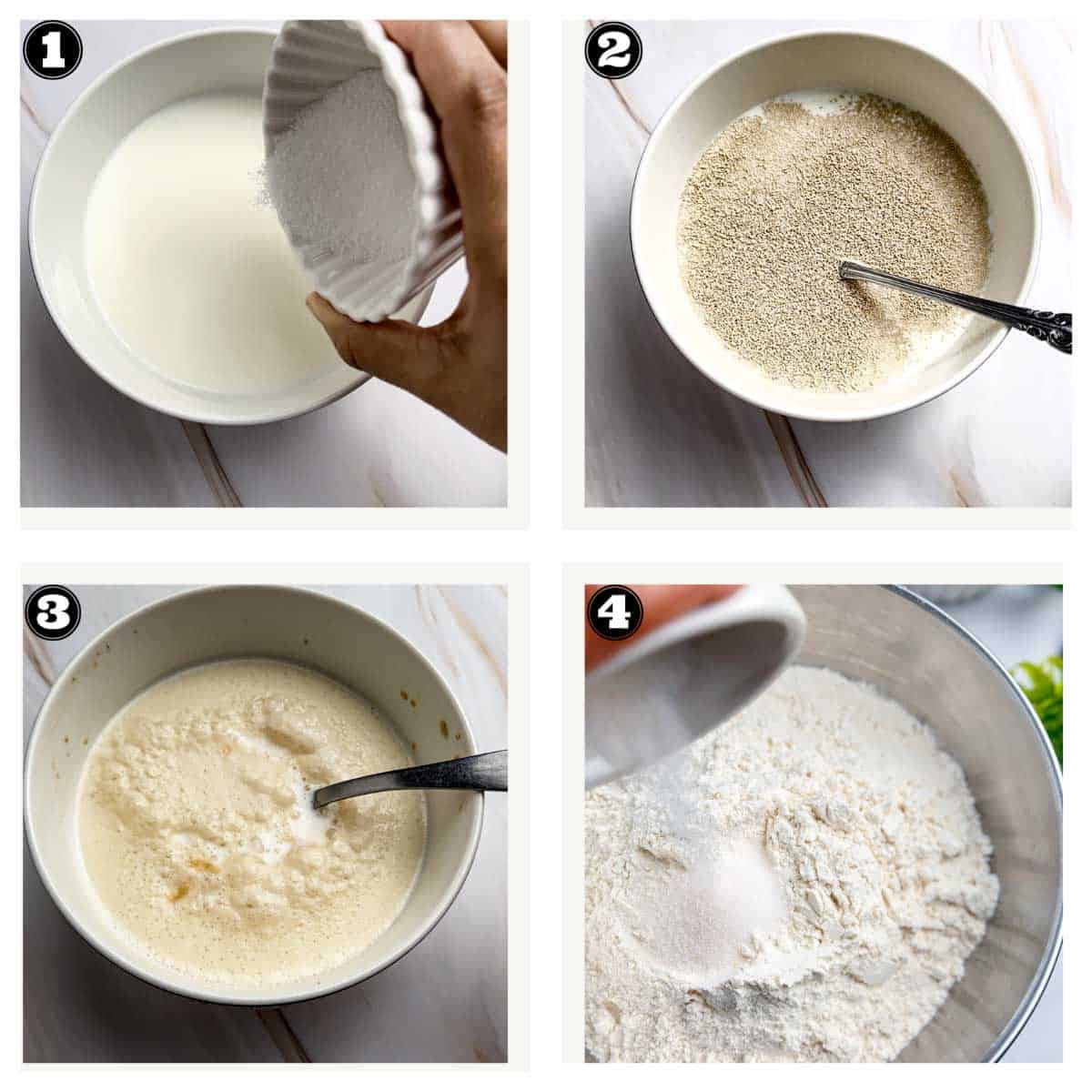
Allow the yeast to sit undisturbed for about 5 to 10 minutes. During this time, the yeast should absorb the moisture, become activated, and start producing bubbles. You may notice a frothy layer on top.
If there is no foam, the yeast may be inactive or the milk may have been too hot or too cold. This is your sign to start again.
If you are using instant yeast, there is no need to bloom it. You can simply add it to flour along with other dry ingredients.
Step 2 Kneading the dough
To knead the dough for the Ube Cinnamon Rolls recipe using a stand mixer, begin by attaching the dough hook to the mixer. In the mixing bowl, combine the bread flour, salt, and 2 teaspoon ube paste.
Start the stand mixer on low speed to initially incorporate the ingredients. Gradually increase the speed to medium as the dough forms. Allow the stand mixer to knead the dough for about 8 to 10 minutes until it becomes smooth and elastic.

Now start adding softened butter in stages. Periodically stop the mixer to scrape down the sides of the bowl, ensuring all ingredients are evenly integrated.
The dough is ready when it is tacky but not overly sticky and easily pulls away from the sides of the bowl. Once kneaded to perfection, remove the dough, and form it into a ball.
Step 3 Fermenting the dough
Fermenting dough is a crucial step in the bread-making process, allowing the yeast to work its magic and develop flavor and texture.
After kneading the dough, shape it into a ball and place it in a lightly oiled bowl. Cover the bowl with a damp cloth or plastic wrap to prevent the dough from drying out. Select a warm, draft-free location for the dough to ferment. Ideal temperatures range between 75°F to 85°F (24°C to 29°C), as this promotes yeast activity.

Allow the dough to rise for the first fermentation phase, typically 1 to 2 hours. During this time, the dough will roughly double in size. This stage enhances the dough's flavor and texture.
If you are not ready to bake the same day you can refrigerate the dough overnight. This process, known as retarding, allows for a longer, slower fermentation and can enhance flavor. Let the dough ferment for an initial 30-40 minutes before putting them in the refrigerator.
Next morning follow the below-mentioned steps for making overnight ube cinnamon rolls.
Step 4 Make the cinnamon sugar filling
To create the delectable Ube Cinnamon Roll filling allow the unsalted butter to soften at room temperature or gently microwave it for a few seconds until easily spreadable.

In a mixing bowl, combine the softened butter and start beating the butter to make it light and airy. Now add brown sugar, salt, and ground cinnamon. Use a spoon or spatula to thoroughly mix the ingredients until a smooth and uniform paste forms.
Taste a small amount of the filling to ensure the balance of sweetness and cinnamon flavor is to your liking. Adjust the quantities of brown sugar or cinnamon if needed.
Creating the Ube Filling
You can also use ube filling in the rolls. For that, you will need ube jam or ube halaya. You can either make it yourself or purchase it from a store.
If you decide to make ube jam, start by boiling peeled and diced ube until it becomes soft and tender. Once cooked, mash the ube and mix it with coconut milk, condensed milk, and sugar. Cook the mixture on low heat until it thickens and becomes a jam-like consistency.
Once you have your ube jam, it's time to prepare the filling. Mix the ube jam with softened butter, brown sugar, and cinnamon until it becomes a smooth and creamy consistency.
Step 5 Shaping ube cinnamon roll
When the dough has fermented and doubled up in volume, it is time to start shaping the ube cinnamon rolls.
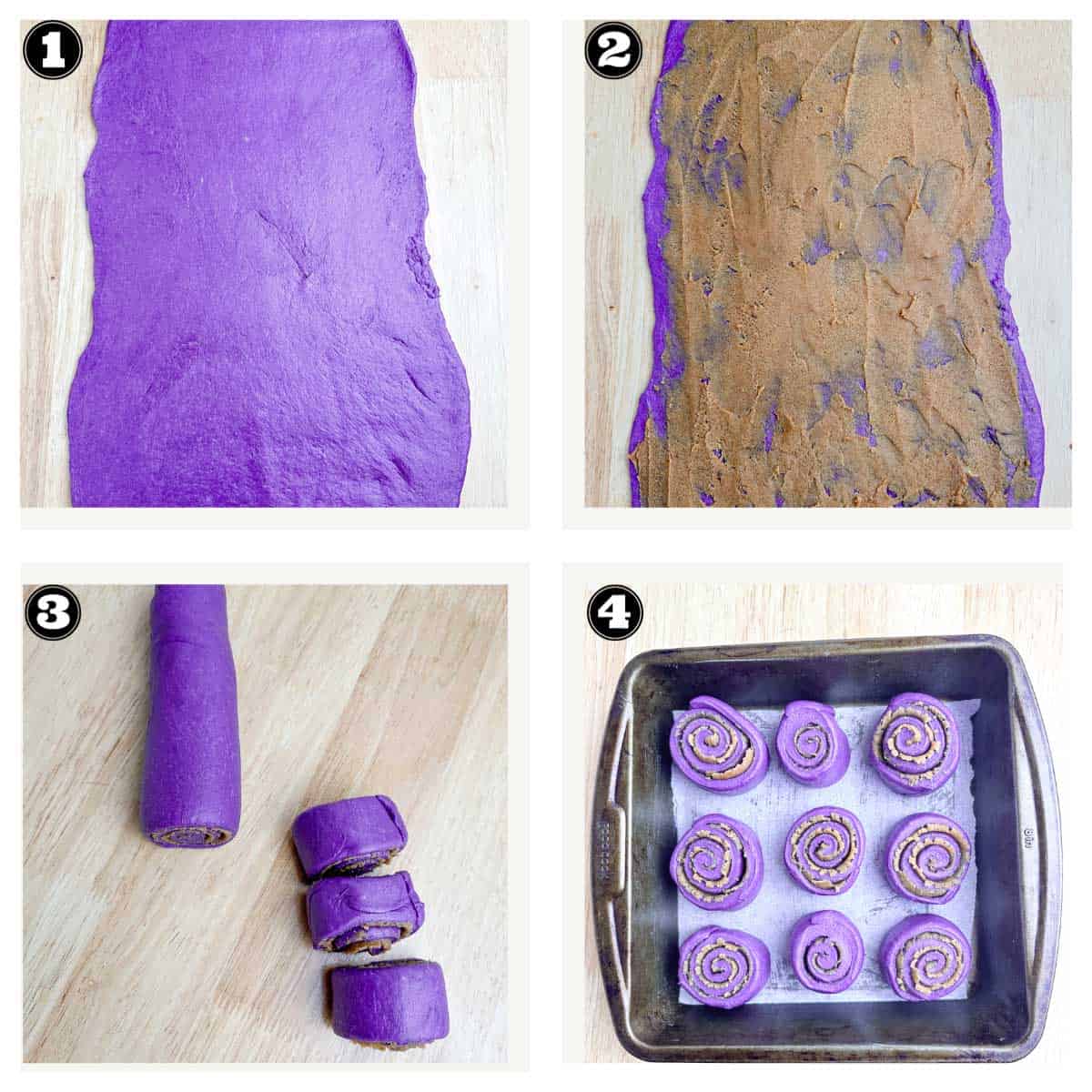
Start by rolling the dough into a rectangular sheet of even thickness using a rolling pin. Now grab an offset spatula and spread the prepared filling evenly over the surface, leaving a small margin along the edges.
Roll the dough into a log, sealing the edges, and then slice it into individual rolls. You can use a knife or dental floss to cut them into individual rolls or equal width. The filling will create a flavorful swirl within each ube roll.
Now transfer them to a baking pan lined with parchment paper leaving enough room for them to rise.
Step 6 Proofing ube cinnamon rolls (second rise)
Cover the proofing rolls with a kitchen towel or a cling wrap to prevent them from drying out. Put them in a warm place and allow them to fluff, rise, and become fuller in volume.
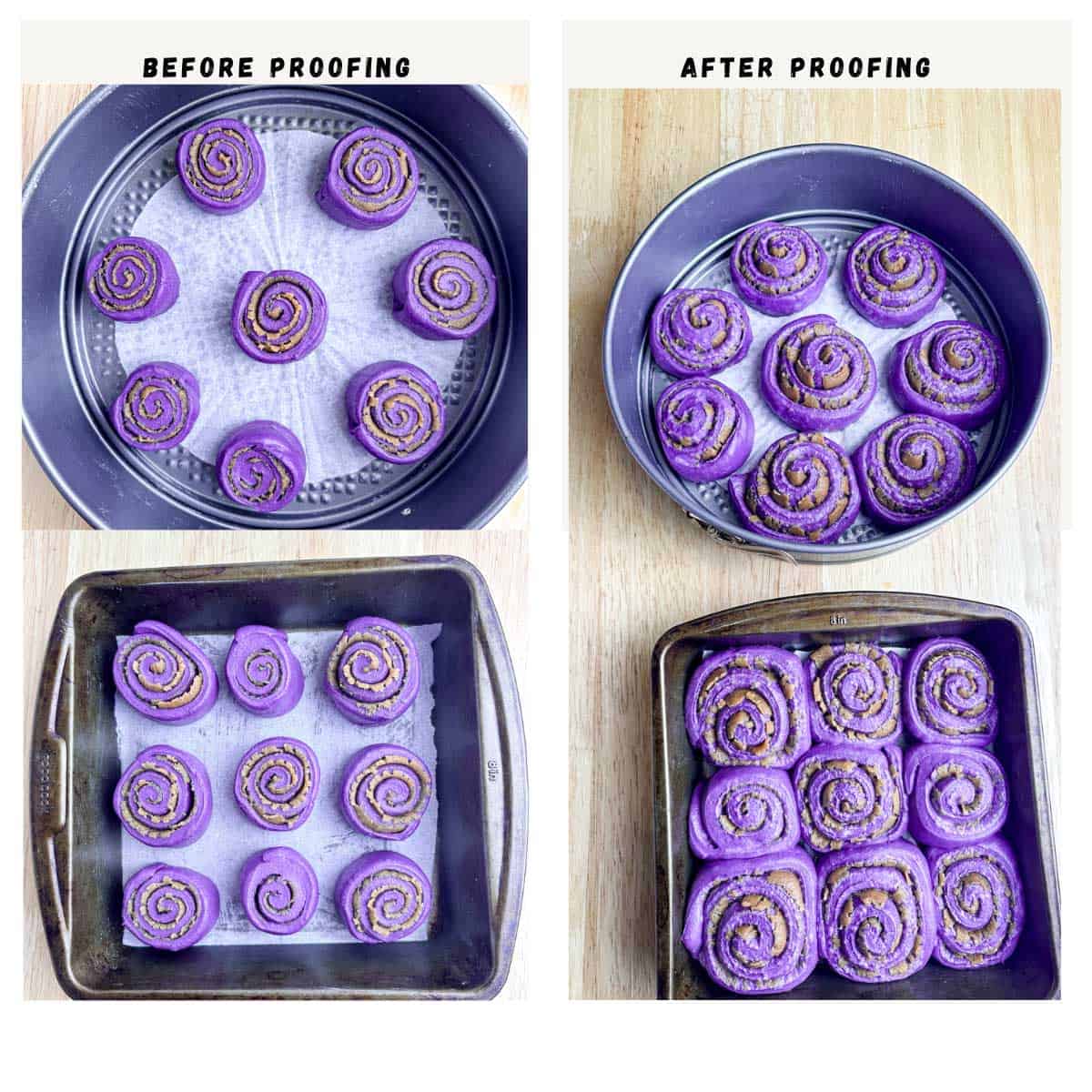
Now they are ready to be baked.
Step 7 Baking Ube Rolls
Preheat the oven to 360 0F(182 oC). Bake the ube cinnamon rolls for about 18-20 minutes or until fully baked. The dark color of the dough makes it difficult to see any color change on the rolls while they are baking in the oven. So, keep a close eye and start checking at the 15-minute timer.
Optionally spray or brush the ube cinnamon rolls with milk before putting them for baking. This ensures a tender and soft crust. The filling will melt and caramelize during baking, creating a deliciously sweet and aromatic center with soft and fluffy crust!
Step 8 Making and Spreading icing

While the ube cinnamon rolls are baking, make the icing for them. In a bowl, combine all the ingredients and whisk well until everything is evenly combined. You can also add ube paste to make ube frosting for the rolls.
Let the rolls cool for 5 minutes before spreading the frosting on warm ube cinnamon rolls for best results.
🫙Storage Instructions
To store Ube Cinnamon Rolls and keep them fresh, follow these steps:
- Allow to Cool Completely: Before storing, ensure that the Ube Cinnamon Rolls have cooled completely. Storing them while still warm can create excess moisture, potentially leading to sogginess and attracting mold later.
- Choose an Airtight Container or Wrap: Place them in an airtight container or wrap them tightly with plastic wrap. This helps prevent the rolls from drying out and keeps them moist.
- Refrigerate for Short-Term Storage: Store at room temperature for 2-3 days. For short-term storage (>3 days), you can refrigerate the Ube Cinnamon Rolls. This is especially important if the rolls contain perishable ingredients like cream cheese frosting. Place them in the fridge in their airtight container.
- Freeze for Longer Storage: If you want to store the rolls for an extended period, consider freezing them. Wrap each roll individually in plastic wrap and then place them in a sealed freezer bag. Label the bag with the date for easy tracking.
- Avoid Stacking Too Tightly: Whether refrigerating or freezing, try to avoid stacking the rolls too tightly to prevent squishing and distortion of their shape. If stacking is necessary, place a sheet of parchment paper between layers to prevent sticking.
- Thawing Frozen Rolls: When ready to enjoy frozen Ube Cinnamon Rolls, remove them from the freezer and let them thaw at room temperature or warm them up in the oven.You can also spray them with water and microwave individual rolls for a quick thaw.
- Reheat if Desired: If you prefer warm cinnamon rolls, you can reheat them in the microwave or oven before serving. Be cautious not to overheat, as this can dry out the rolls. You can spray them with milk before reheating them. This will yield moist cinnamon rolls.
💭Pro tips to make softer and fluffier cinnamon rolls
By adhering to these points you can turn any ordinary cinnamon roll recipe to perfectly crafted cinnamon rolls.
- Choose the right floor: All-Purpose Vs Bread Flour
All-purpose flour is a common choice for baking, but bread flour may be a better option for cinnamon rolls. Bread flour has a higher protein content, which helps create more gluten in the dough. This, in turn leads to a chewier and more elastic texture, which can make the rolls softer and fluffier.
However, if you don't have bread flour on hand, all-purpose flour can still work well. - Incorporating Fat in the dough
One of the key ingredients in making a soft and fluffy dough is fat. Whether you use butter, oil, or another type of fat, it helps to keep the dough moist and tender. When incorporating the fat into the dough, it is important to make sure it is evenly distributed. So add butter in stages while kneading the dough. - Proper Kneading Techniques
Kneading the dough is an essential step in developing the gluten and creating a soft and fluffy texture. However, it is important not to over-knead the dough, as this can result in a tough and chewy texture. The dough should be kneaded until it is smooth and elastic, but still slightly sticky. - Optimum proofing
The dough should be left to rise in a warm, draft-free area until it has doubled in size. - Bake them right!
The oven temperature is one of the most crucial factors in making soft and fluffy cinnamon rolls. If the temperature is too high, the cinnamon rolls will cook too quickly on the outside, leaving the inside undercooked. Conversely, if the temperature is too low, the cinnamon rolls will take too long to cook, resulting in a dry and tough texture.
To achieve the perfect temperature, preheat the oven to 360°F (182°C) and place the cinnamon rolls on the middle rack. This temperature ensures that the cinnamon rolls cook evenly and retain their moisture.
Use an external thermometer to check the real temperature of the oven. Spraying a little milk right before baking can help them stay moist and soft after baking.

🥖More bread recipes and rolls
- Semolina Bread with Sesame Seeds
- Turkish Bread
- Dairy free bread: The best whole wheat vegan milk bread
- Tiger rolls: A foolproof Dutch crunch bread recipe
- Matcha Bread (Eggless Matcha Swirl Bread)
- Coffee Buns ( Eggless Mexican Bun Recipe)
- Sourdough Rolls | No-yeast quick dinner rolls using sourdough starter
- Ragi roti
- Chocolate rolls
🥬More vegan bread recipes
A few vegan bread recipes
- The best garlic sourdough bread recipe
- Sourdough chocolate bread recipe: Easy and delicious !
- How to make sourdough hot dog buns from scratch?
- Ciabatta bread
- Vegan challah buns
- Dairy Free bread
- Vegan Hamburger Buns

I hope you thoroughly enjoy indulging in this Ube Cinnamon Rolls recipe! Your feedback means the world to us, so please take a moment to leave a review.
Bake it delicious!
Till then
Bake it Delicious!
📝 Recipe Card
Ube Cinnamon Rolls
Ingredients
Ingredients for the dough
- 400 g Bread flour 3 cups leveled
- 245 g whole milk 1 cup
- 12 g sugar 1 tbsp
- 7 g active dry yeast 1 pkg
- 42 g butter softened 3tbsp
- 2 teaspoon Ube paste
- 8 g salt 1 ½ tsp
Ingredients for filling
- 58 g unsalted butter 4 tbsp
- 105 g brown sugar ⅔ cup
- ¼ teaspoon salt
- 2 teaspoon ground cinnamon
Ingredients for icing
- 2 cups powdered sugar
- 4 tablespoon heavy cream
- 1 tablespoon melted butter
- 1 teaspoon vanilla
Instructions
Step 1: Blooming the Yeast
- Blooming yeast is crucial to activate it before adding it to the dough. Warm the milk to 110°F (43°C). Dissolve sugar in the warm milk. Sprinkle active dry yeast over the mixture and let it sit for 5-10 minutes until frothy. If no foam forms, restart the process. Instant yeast users can skip blooming and add it directly to dry ingredients.
Step 2: Kneading the ube Dough
- Using a stand mixer, attach the dough hook and combine bread flour, salt, and ube paste. Start on low, gradually increasing to medium as the dough forms. Knead for 8-10 minutes, adding softened butter in stages. Stop to scrape down the bowl, ensuring even integration. The dough is ready when tacky but not overly sticky. Remove and shape into a ball.
Step 3: Fermenting the Dough
- After kneading, shape the dough into a ball and place it in an oiled bowl, covering it to prevent drying. Allow it to rise in a warm spot (75°F to 85°F) for 1 to 2 hours, doubling in size for enhanced flavor. For overnight baking, refrigerate the dough, known as retarding, for extended fermentation. Let it ferment for 30-40 minutes before refrigeration, then follow the steps for making overnight Ube Cinnamon Rolls the next morning.
Step 4: Making the Cinnamon Sugar Filling
- In a bowl take softened unsalted butter and beat until light. Now combine brown sugar, salt, and ground cinnamon, creating a smooth paste. Taste to adjust sweetness and cinnamon levels.
Step 5: Shaping Ube Cinnamon Roll
- After the dough doubles in volume, roll it into a rectangle. Use an offset spatula to spread the filling evenly, leaving a margin. Roll it into a log, seal the edges, and slice it into individual rolls. Place them in a parchment-lined baking pan, while leaving space for rising.
Step 6 Proofing ube cinnamon rolls (second rise)
- Cover them with a kitchen towel or a cling wrap to prevent them from drying out. Put them in a warm place and allow them to become fluffy, rise, and become fuller in volume.
Step 7 Baking
- Preheat the oven to 360 0F. Bake the ube cinnamon rolls for about 18-20 minutes or until fully baked.
- The purple color of the dough makes it difficult to see any color change on the rolls while they are baking in the oven. So, keep a close eye and start checking at the 15-minute timer.
Step 8 Making and Spreading icing
- While the ube cinnamon rolls are baking, make the icing. In a bowl, combine all the ingredients and whisk well until everything is evenly combined.
- Let the rolls cool for 5 minutes and then spread the frosting on warm ube cinnamon rolls.
Notes
• If you are using instant yeast, there is no need to bloom it. You can simply add it to flour along with other dry ingredients.
• While preparing the dough, add butter in stages. One cube of butter at a time. This allows even incorporation of the butter into the dough.
• If the filling seems too thick, you can add a little more softened butter to achieve a spreadable consistency. Conversely, if it's too runny, add a bit more brown sugar until you reach the desired thickness.
• Taste a small amount of the filling to ensure the balance of sweetness and cinnamon flavor is to your liking. Adjust the quantities of brown sugar or cinnamon if needed.
• Spray or brush the ube cinnamon rolls with milk before putting them for baking. This ensures a tender and soft crust.
📋Nutrition Facts
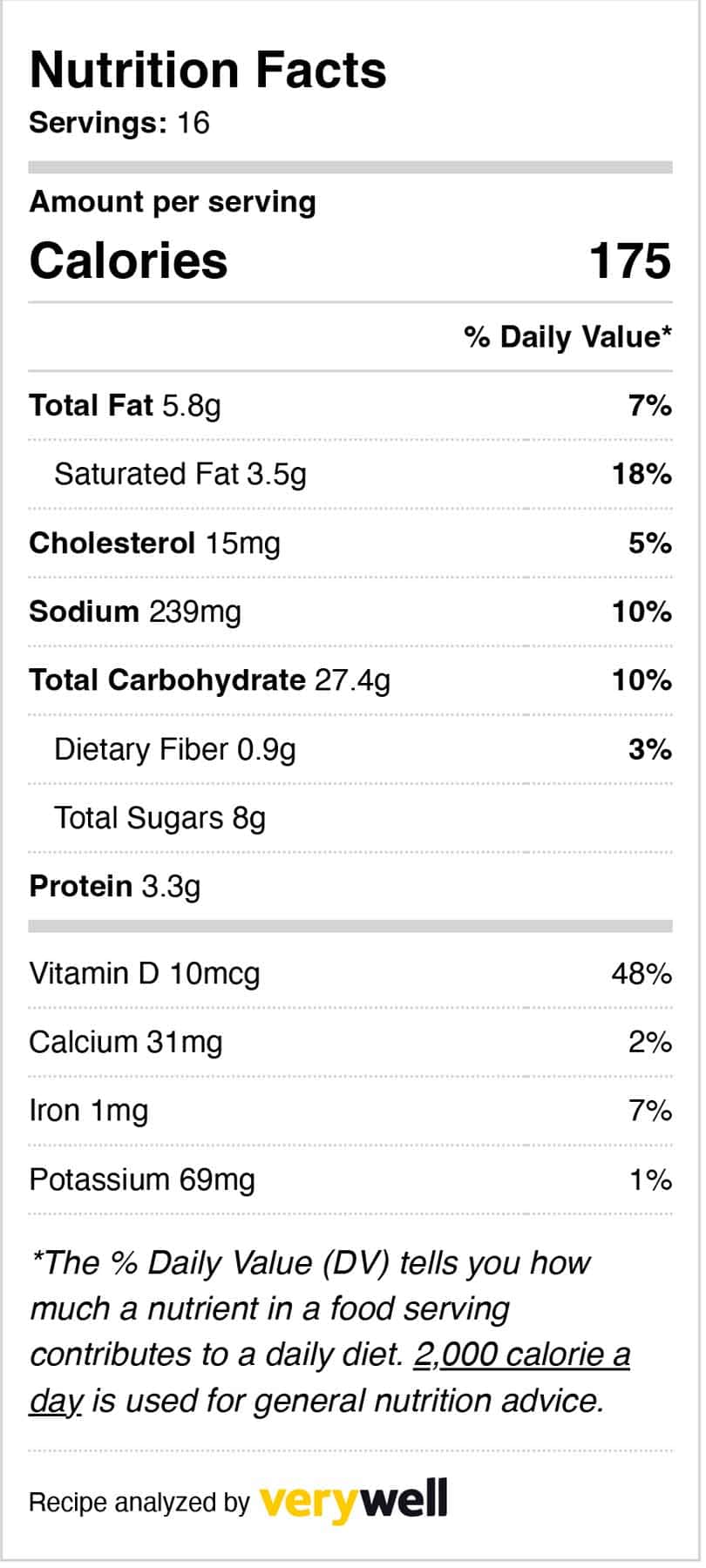






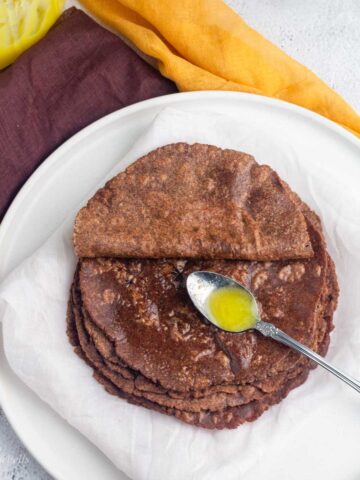
Leave a Reply